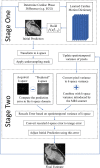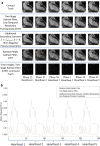A predictive signal model for dynamic cardiac magnetic resonance imaging
- PMID: 37357251
- PMCID: PMC10290992
- DOI: 10.1038/s41598-023-37475-5
A predictive signal model for dynamic cardiac magnetic resonance imaging
Abstract
Robust dynamic cardiac magnetic resonance imaging (MRI) has been a long-standing endeavor-as real-time imaging can provide information on the temporal signatures of disease we currently cannot assess-with the past decade seeing remarkable advances in acceleration using compressed sensing (CS) and artificial intelligence (AI). However, substantial limitations to real-time imaging remain and reconstruction quality is not always guaranteed. To improve reconstruction fidelity in dynamic cardiac MRI, we propose a novel predictive signal model that uses a priori statistics to adaptively predict temporal cardiac dynamics. By using a small training set obtained from the same patient, the new signal model can achieve robust dynamic cardiac MRI in the presence of irregular cardiac rhythm. Evaluation on simulated irregular cardiac dynamics and prospectively undersampled clinical cardiac MRI data demonstrate improved reconstruction quality for two reconstruction frameworks: Kalman filter and CS. The predictive model also works with different undersampling patterns (cartesian, radial, spiral) and can serve as a versatile foundation for robust dynamic cardiac MRI.
© 2023. The Author(s).
Conflict of interest statement
The authors declare no competing interests.
Figures







References
Publication types
MeSH terms
Grants and funding
LinkOut - more resources
Full Text Sources
Miscellaneous

